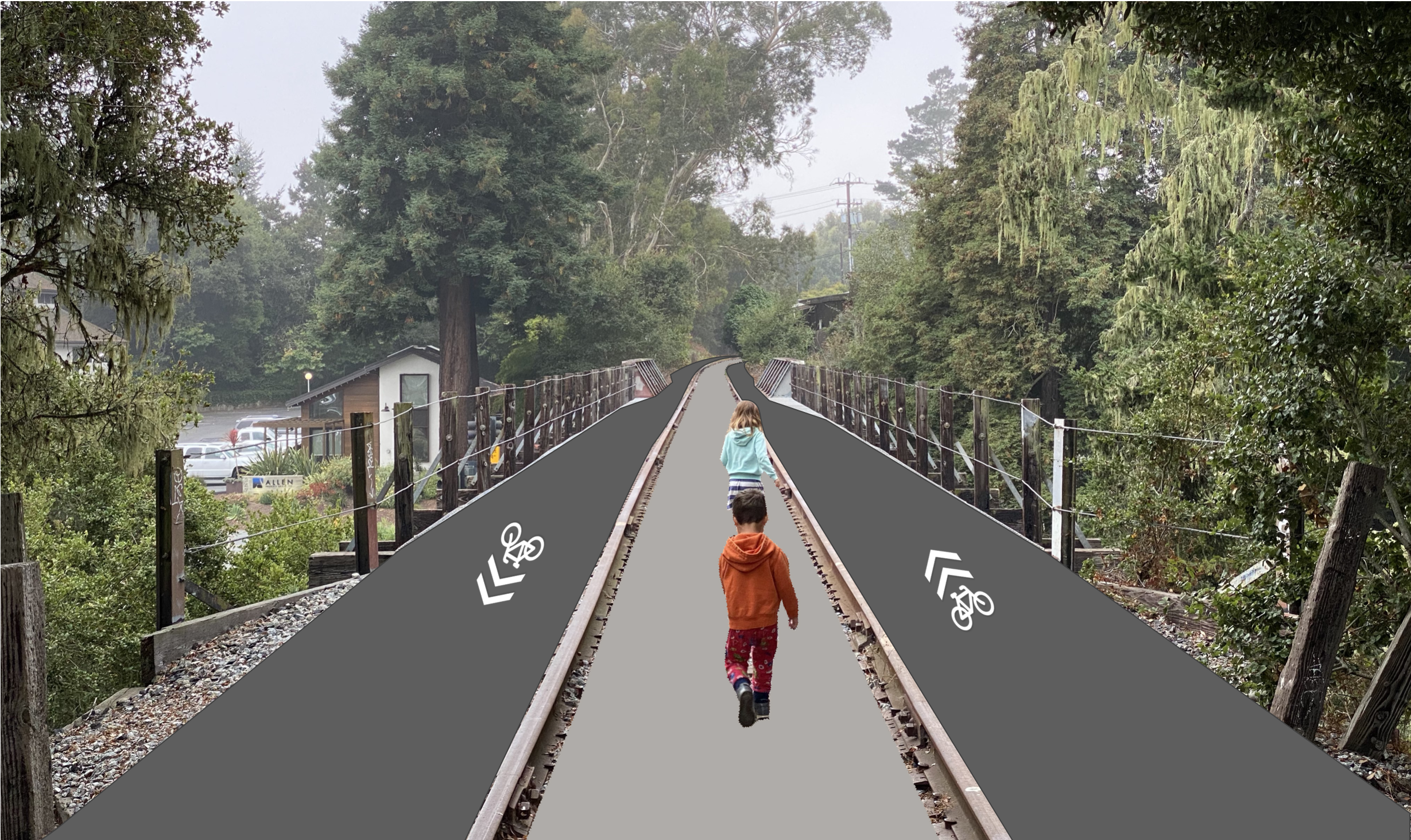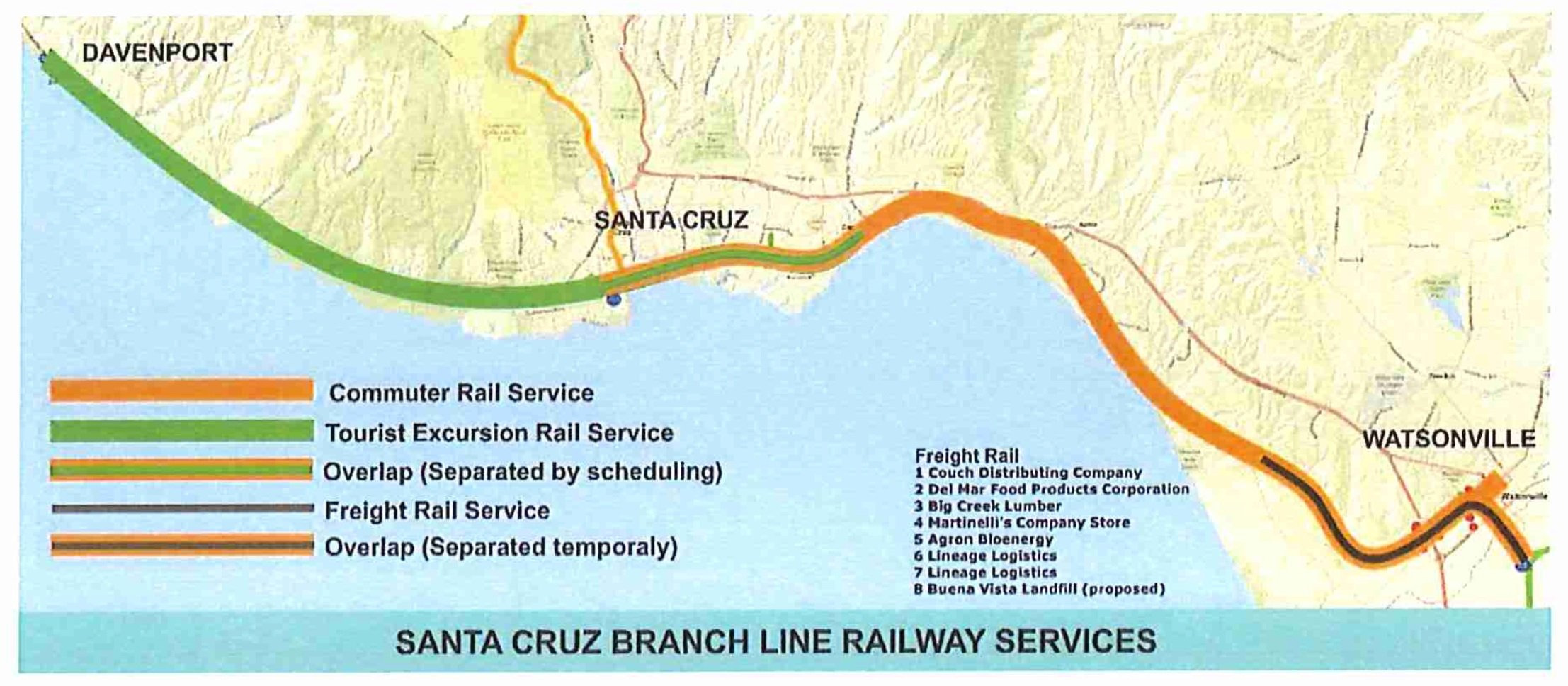TL;DR
Aptos Handshake:
A proposal to turn the Aptos Strangler into something a lot less scary

What’s up with this?
Give a listen to this Q&A Monologue to better understand the deal on the Santa Cruz rail corridor running through Aptos.
Don’t be fooled
This is not a 2-sided issue. It’s a complex, contentious, multi-sided issue.
But you’re smart, you can understand this. NRG isn’t asking you to trust us, we’re asking for your attention.
Learn more, then trust yourself.
Once you feel like you have a handle on it, spread the word, even if you disagree with NRG’s neutral stance.
What about that cool streetcar demo?
Yea! Wasn’t that neat?
There are tons of unknowns, but Roaring Camp recently sponsored a demonstration of a light streetcar from TIG/m. This Coast Futura demo showed Santa Cruz County what we can have if we railbank: trail AND rail streetcar!
Why do we have to railbank to get something like this?
Well, we don’t have to, but there are significant compatibility challenges between freight & light rail.
Light EMU/DMU are Non-FRA Compliant but can use an active freight line through temporal sharing (e.g. Light EMU during the day, freight at night). However, electric trolleys, trams, and streetcars are generally prohibited from using a single-track active freight line. FRA may approve an exception as long as risks are as low as reasonably achievable, but this is considered on a case-by-case basis.
In TIG/m’s unsolicited proposal to SCCRTC (concept map below), likelihood of FRA approval could be increased by railbanking the corridor north of Watsonville and installing operable safety gates for physical separation at the active/railbanked interchange.
Forget Freight!
Monterey gets it!
SCCRTC & TAMC both have their finger on the pulse of rail transit opportunities.
One of the key differences here is that freight is already abandoned on the Monterey Branch Rail Line. This literally paved the way for the Monterey Bay Coastal Recreation Trail, a wildly popular 18-mile mixed-use recreational trail built right on top of the abandoned tracks, which are now buried underneath the paved trail.
But remember - abandoning freight & building a trail does not kill the prospect of rail transit! In fact, TAMC has proposed a new light rail transit project. TAMC is also coordinating with MST to explore use of the corridor for a new busway & bus rapid transit (BRT).
What about that upcoming ballot measure?
If the ballot measure passes this June, the county’s General Plan will be amended to eliminated rail planning. If the measure fails to pass, we’ll be stuck with the stagnant status quo.
NRG recommends abstaining unless an amicable agreement can be reached between all parties. As SCCRTC Executive Director Guy Preston has repeatedly said, “The best way of moving forward would be to get all parties to agree.”
It is not straightforward to modify the measure, but the initiative does grant the Board of Supervisors authority to adopt modifications proposed or requested by the California Coastal Commission.
NRG’s proposed modifications to Greenway’s initiative shown below are an example of how we could compromise to support trail+transit planning on the railbanked corridor - ditch freight but keep passenger rail! 🚲🤝🚊
https://www.yes-greenway.org/initiative
Isn’t there already a plan for the rail corridor?
Yup! It’s called the Monterey Bay Scenic Sanctuary Trail (MBSST) Network Master Plan, and the Coastal Rail Trail is an important component of it. This plan was finalized in 2014 and remains the official development plan for the Santa Cruz Branch Rail Line (SCBRL).
It’s kind of a “have our cake & eat it too” sort of plan, with the multi-use trail built adjacent to the active freight line. As depicted, this provides freight cargo transport capability along the tracks, which would retain legal prioritization for freight over passenger rail transit or any other use of the corridor.
Multi-use trail bridge adjacent to existing tracks
Remember, our branch line is currently a non-operational active freight line. Restoring operational freight would be beneficial to Roaring Camp, and could potentially reduce transport costs for local businesses like Big Creek Lumber, increasing their ability to compete.
In fact, Roaring Camp has the authority to object to railbanking even if county voters and SCCRTC approve it. Federal STB approval is required for successful railbanking, and an objection from Roaring Camp would be a significant factor for consideration. Regardless of railbanking, Roaring Camp is a valued local business and their existing operations should be protected (e.g. tourist train to the Boardwalk & freight in Watsonville).
Yea, but what about Aptos?
Now we’re talking! Aptos is what NRG is all about! This section of the rail corridor, Segment 12, is one of the most constrained portions. This area also happens to be the transportation bottleneck of Santa Cruz County.
However, as depicted in the Unified Corridor Study (UCS), Aptos could be the world-class hub of a sustainable transit network. Instead, it’s not even on the map! NRG wants to help Aptos transform for the better.
Multi-use trail bridge adjacent to existing tracks
The rail line through Segment 12 currently includes the following bridges, some of which are adjoining:
Over HW 1 (Seacliff)
Over Soquel Dr (at Spreckels Dr)
Over Aptos Creek
Over Soquel Dr (at Aptos St)
Over Valencia Creek
Over HW 1 (RDM)
Ideally, the existing rail bridges would be retained for future transit development and new trail bridges would be added. In fact, that’s the official plan!
However, a plan is not a design, and a design is not a completed project.
As it stands, the biggest risk of a commuter rail project has always been funding. In addition to financing the initial build (~$470M), SCCRTC anticipates that an additional sales tax would be needed to fund operations & maintenance (O&M) for passenger rail transit (estimated to be $25M/yr). However, with sufficient funding and continued planning & development, SCCRTC estimates 14 years for implementation.
We should build new dedicated trail bridges where budget allows, and authorize (through railbanking) interim trail use of existing rail bridges until new infrastructure is built & rail transit is operational.
Why is this so important for NRG & Aptos?
Well, as evident in the Strava Heatmap, community members are frequently using the rail line to get from RDM to Aptos Village on foot & by bike.
So plenty of people are walking the tracks now, even though they’re not authorized to do so and the path is not conditioned for trail use.
Local teens are among those most reliant on this route. They have enough independence to explore but often no car in which to do so. There are currently no direct or safe roadways between Rio Del Mar and Aptos Village (the gateway to Nisene Marks State Park).
Soquel Dr & Spreckels Dr are the only two roadway options, and they are currently unsafe for pedestrians & cyclists and are out of the way for most RDM residents. NRG has a Complete Streets Vision for Aptos, but the Coastal Rail Trail is a critical component of our vision.

So what’s the problem?
Well, as is often the case - we don’t have enough money to get all the things we want.
Unfortunately, the new Infrastructure Investment and Jobs Act (IIJA) isn’t likely to solve our problems here.
Measure D & SB1 remain primary funding sources for new transportation projects in Santa Cruz County, and this pie isn’t large enough to feed everyone’s appetite.
We can’t have our cake and eat it too
Rail preservationists want to keep freight active. Greenway wants uber-wide trail-only. We can’t have our cake and eat it too.
Besides, this is an ice cream cake! Every year it sits idle it melts a little more.
Let’s not let another birthday go by with more stagnation. Let’s put the cake in the fridge and find another dessert to enjoy now, like railbanked trail+transit!
But we can’t wait for sustainable, equitable transit!
I agree! And although we do have to be patient for rail corridor development, we don’t have to wait to improve sustainable & equitable transit options.
The people of Watsonville can’t wait 14 years for rail service - they need proper solutions now! While transit development continues on the corridor, let’s find ways to drastically improve METRO bus service in the near-term.
There are many ways to drastically improve & modernize METRO service, but they all require money that’s not currently available. Meanwhile, SCCRTC anticipates that passenger rail transit would require a new 30-year half-cent county-wide sales tax to fund the $25M/year cost of operations & maintenance (O&M).
That may not be easy to swallow, but maybe it’s the medicine we need. Point is, let’s secure the O&M funding before we spend $470M for the initial build. While we’re waiting patiently for rail transit, think of how METRO could use that $25M/year!
Although electric light rail is more sustainable than bus, we clearly still need to improve the bus system for first & last mile service. Furthermore, the more people using bus instead of single-occupant vehicles, the less emissions & congestion. Bus service is already more affordable than private automobile ownership, but many people choose to own a car regardless. How can we help motivate people to use their car less while also improving METRO’s service & equitability? Well how does this sound - better service, free fare.
Sound like a pipe dream? Maybe. Maybe not. Imagine if we had that $25M/year now instead of later when rail transit is ready.
According to METRO’s financial statements, total revenue is ~$10M/year. So with a new inflow of $25M/year, METRO could offer free fare for all and have an extra ~$15M/year for service improvements & modernization.
This way, we could bring more sustainable & equitable transit to Santa Cruz County now, while also lining up funding for future rail transit. Once electric light rail service begins, METRO could then resume collecting fares (perhaps with subsidies for eligible passengers) and the people of Watsonville will finally have an affordable & congestion-free transit option to Santa Cruz!
Monterey gets it, remember?
They not only built the spectacular 16-mile multi-use Monterey Bay Coastal Recreation Trail, they’re also looking into a dedicated busway along the abandoned tracks and associated Bus Rapid Transit (BRT) service, and light rail transit!
How wide is wide enough?
The answer isn’t 42.
According to Greenway, the preferred Coastal Rail Trail width would be 26ft. According to SCCRTC, standard width would be 12ft and absolute minimum width would be 8ft. Where feasible, SCCRTC is targeting a range of 12-16ft.
Ok but umm is that wide enough?
Well, the rail trail in Monterey receives upwards of 2000 people per day, but the peak hourly usage number is unclear. Another popular waterfront trail, Chicago’s 20-25ft wide Lakefront Trail, averaged 2320 users per hour in 2013 during planning for Chicago’s own rail trail project. That hourly average is helpful, but it’s not an estimate of peak usage. Furthermore, Chicago’s population is about 4x larger than Santa Cruz & Monterey counties’ combined.
Greenway has referenced a helpful 2018 study that shows peak hourly capacity based on trail width. Problem is, it only has one data point for a trail with separated bike & pedestrian paths. Still, by analyzing the relationships specified in the data, some general conclusions can be drawn.
For one, path separation has minimal effect on pedestrian capacity but significantly increases cyclist throughput. Logically, this makes sense, given that cyclists must yield to pedestrians. Secondly, 26ft is pretty absurdly wide for the Santa Cruz Coastal Rail Trail.
A 16ft wide separated trail could handle about 2100 cyclists & 440 pedestrians per hour!
According to SCCRTC, the Coastal Rail Trail is being designed to a Caltrans defined 12ft standard minimum which includes an 8ft paved portion and 2ft paved or unpaved buffers on each side. For reference, a typical bike lane is 4-5ft (two way would total 8-10ft) and a typical sidewalk is about 4ft wide.
A 12ft wide separated trail with 8ft for cyclists & 4ft for pedestrians could handle about 1300 cyclists & 270 pedestrians per hour.
By focusing first on building Trailway as an 8-12ft mixed-use trail and reserving 8-17ft for future Transitway development, we can ensure that our rail corridor best accommodates the present & future needs of residents & visitors.
Facts & FAQs
-
Why did NRG throw its hat in the ring? Well, it’s our Mission to promote & improve the parks & pathways in Aptos.
Turns out all 3 of Santa Cruz County’s primary transportation corridors converge in Aptos! This positions Aptos as either a chokepoint, a hub, or both. NRG’s Vision is one of Aptos as a healthy, interconnected hub.
Plus, we think people here in the community should get along, not bicker! After all, you can’t spell community without unity! ✌️🤝👍
-
Really - NRG has always been neutral on the rail corridor and has always advocated for bipartisan collaboration.
NRG encourages diverse perspective within our supporter base, board of directors, and advisory board. In fact, NRG’s boards include board members of both FORT and Greenway.
It’s kind of obvious that the city of Santa Cruz would benefit most from trail-only and the city of Watsonville would benefit most from rail development.
Here in unincorporated Aptos, we’re at the center of it all. We’re choked by converging transportation corridors, sorely lacking in basic accommodations for pedestrians & cyclists, and would clearly benefit from both trail AND rail transit.
But something’s gotta give. In order to back down from trail-only development, we have to give up freight.
-
*Stay tuned for the answer!
-
*Stay tuned for the answer!
-
Of course!
Well, I mean, that is as long as we plan for that. It’s unlikely the tracks would ever come back if removed for trail-only development.
But if we don’t railbank, developing light rail transit would be complicated by the active freight line. For example, FRA wouldn’t permit streeetcars, trams, or trolleys to operate on the tracks at all!
So let’s deactivate freight, railbank the corridor, and develop trail & transit!
-
*Stay tuned for the answer!
-
According to SCCRTC, “Another freight operator can make an Offer of Financial Assistance (OFA) to maintain the line and assume the legal obligation to provide freight service. A freight rail customer or the owner of a potential stranded line would have grounds to object to abandonment and railbanking. The STB will not refuse to issue a railbanking order based on third-party objections about the desirability or appropriateness of the proposed use.”
Since there are currently no active freight rail customers north of Watsonville and Roaring camp is the only owner of a potentially stranded line, this means that Roaring Camp is the only entity with legal grounds to object to railbanking. Doesn’t really matter how much the public kicks & screams one way or another - the fate of the rail corridor rests between SCCRTC, Progressive Rail, and Roaring Camp. Since Progressive Rail has previously expressed intent to abandon, it’s really SCCRTC & Roaring Camp that need to come together here.
“The best path to railbanking is to have the mutual support of all affected parties, including the freight operator, affected freight customers, and owners of potential stranded lines.” -
NRG is a nonpartisan nonprofit and has no financial motives here, and our support for trail+transit is independent of railbanking.
Accusations against Greenway have claimed that “they” would get a big payout from the federal government if the corridor is railbanked. These claims have never been substantiated or (more importantly) quantified.
Accusations against rail transit supporters have claimed that “they” are backed by wealthy developers that would exploit transit to build new high density development for a big profit. No evidence has been provided to legitimize this claim.
Accusations against freight preservationists have claimed that, wait, no… these aren’t accusations these are assertions by the preservationists themselves! Retaining active freight would financially benefit Roaring Camp and other local businesses by expanding or reducing cost of their operation. -
Wow, I appreciate your candor. I don’t really hear anyone legitimately proposing this, but I suspect there may be a number of influential NIMBYs & BANANAs behind the scenes here.
Santa Cruz has long been characterized as “anti-development,” so this isn’t an unreasonable suspicion. “If you don’t build it, they won’t come.” Still, it would be a wildly unpopular position to oppose development of the rail corridor.
So, how might a covert NIMBY support this agenda? Well, fanning the flames of endless debate might keep the corridor perpetually ensnarled.
Learn More, Argue Less
-
-
-
-
Monterey Bay Sanctuary Scenic Trail Network (Coastal Rail Trail)
Potential Adverse Abandonment Action for Freight Service Only on the Felton Branch Line
SCCRTC & Progressive Rail: Administration, Coordination, and License (ACL) Agreement
Approved Projects: Regional Transportation Improvement Program (RTIP)
-
After condemnation, RTC confirms consideration of Felton line abandonment
Good Times: Roaring Camp Takes Over Watsonville Freight Service
YouTube: Heavy rail machinery - Lifting and removing old rail track panels
Aptos man tries to get community on board with rail corridor idea
YES GREENWAY submits signatures, awaits Santa Cruz County review
-
NRG’s Aptos Handshake Petition to Greenway & FORT



























